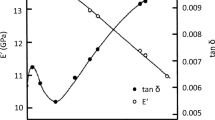Abstract
In this study, changes in the vibro-mechanical properties of fungi-treated wood, during sorption and desorption at different humidity levels, were investigated. Norway spruce resonance wood (with uniform narrow annual rings and high tonal quality for musical instrument craftsmanship) was incubated with Physisporinus vitreus for 36 weeks. Stiffness, internal friction, and tonal performance indices of control (untreated) and fungi-treated wood were compared after exposure to a stepwise variation of relative humidity. It was demonstrated that fungal treatment increased the internal friction and decreased the specific modulus of elasticity, during reduction of wood density. Internal friction of both control and fungi-treated wood significantly increased during dynamic sorption, especially during early stages (hours) of each humidity change step. Both specific modulus of elasticity and internal friction showed a hysteretic behavior during humidity variation cycles. Hysteresis was smaller in fungi-treated wood. Also, tonal performance indices were improved after fungal treatment and showed a reduced variation at different relative humidity conditions. Dynamic vapor sorption tests and FT-IR microscopy studies revealed changes in hygroscopicity and the supramolecular structure of wood, which may explain the observed vibrational behavior. Less dependency of wood vibrational properties to the variation of the ambient humidity is important for the acoustic performance of string instruments.








Similar content being viewed by others
References
Gibson LJ (2012) The hierarchical structure and mechanics of plant materials. J R Soc Interface 9:2749–2766
Wegst UGK (2006) Wood for sound. Am J Bot 93(10):1439–1448
Skaar C (1998) Wood–water relations. Springer-Verlag, Berlin
Sasaki T, Norimoto M, Yamada T, Rowell RM (1988) Effect of moisture on the acoustical properties of wood. J Jpn Wood Res Soc 34(10):794–803
Quarles SL (1990) Effect of moisture content and ring angle on the propagation of acoustic signals in wood. J Acoust Emiss 9(3):189–195
Akitsu H, Norimoto M, Morooka T, Rowell RM (1993) Effect of humidity on vibrational properties of chemically modified wood. Wood Fiber Sci 25(3):250–260
Ebrahimzadeh PR, McQueen DH (1998) A model of the dynamic mechanical responses of wood, paper and some polymers to moisture changes. J Mater Sci 33:1201–1209. doi:10.1023/A:1004373525437
Hernandez RE (2007) Moisture sorption properties of hardwoods as affected by their extraneous substances, wood density, and interlocked grain. Wood Fiber Sci 39:132–145
Song K, Yin Y, Salmén L, Xiao F, Jiang X (2014) Changes in the properties of wood cell walls during the transformation from sapwood to heartwood. J Mater Sci 49:1734–1742. doi:10.1007/s10853-013-7860-1
Goswami L, Eder M, Gierlinger G, Burgert B (2008) Inducing large deformation in wood cell walls by enzymatic modification. J Mater Sci 43:1286–1291. doi:10.1007/s10853-007-2162-0
Hill CAS, Ramsay J, Keating B, Laine K, Rautkari L, Hughes M, Constant B (2012) The water vapour sorption properties of thermally modified and densified wood. J Mater Sci 47:3191–3197. doi:10.1007/s10853-011-6154-8
Ganne-Chédeville C, Jääskeläinen AS, Froidevaux J, Hughes M, Navi P (2012) Natural and artificial ageing of spruce wood as observed by FTIR-ATR and UVRR spectroscopy. Holzforschung 66:163–170
Fackler K, Gradinger C, Hinterstoisser B, Messner K, Schwanninger M (2006) Lignin degradation by white rot fungi on spruce wood shavings during short-time solid-state fermentations monitored by near infrared spectroscopy. Enzym Microb Technol 39(7):1476–1483
Schwarze FWMR, Spycher M, Fink S (2008) Superior wood for violins—wood decay fungi as a substitute for cold climate. New Phytol 179:1095–1104
Schwarze FWMR, Schubert M (2011) Physisporinus vitreus: a versatile white-rot fungus for engineering value added wood products. Appl Microbiol Biotechnol 92:431–440
European Committee for Standardization, European Standard EN 113 (1997) Wood preservatives: test method for determining the protective effectiveness against wood destroying basidiomycetes. In: Determination of toxic values. European Committee for Standardization, Brussels
Ono T, Norimoto M (1983) Study on Young’s modulus and internal friction of wood in relation to the evaluation of wood for musical instruments. Jpn J Appl Phys 22:611–614
Obataya E, Ono T, Norimoto M (2000) Vibrational properties of wood along the grain. J Mater Sci 35:2993–3001. doi:10.1023/A:1004782827844
Brémaud I (2006) Diversite´ des bois utilise´s ou utilisables en facture d’instruments de musique (Diversity of woods used or usable in musical instruments making). PhD dissertation, University of Montpellier II, France
Lehringer C, Koch G, Adusumalli RB, Mook WM, Richter K, Militz H (2011) Effect of Physisporinus vitreus on wood properties of Norway spruce. Part 1: aspects of delignification and surface hardness. Holzforschung 65:711–719
Obataya E, Norimoto M, Gril J (1998) The effects of adsorbed water on dynamic mechanical properties of wood. Polymer 39(14):3059–3064
Ishimaru Y, Arai K, Mizutani M, Oshima K, Iida L (2001) Physical and mechanical properties of wood after moisture conditioning. J Wood Sci 47(3):185–191
Flournoy DS, Paul J, Kirk TK, Highley TL (1993) Changes in the size and volume of pores in sweetgum wood during simultaneous rot by phanerochaete chrysosporium burds. Holzforschung 47:297–301
Gilani MS, Schwarze FWMR (2014) Hygric properties of Norway spruce and sycamore after incubation with white rot fungi. Holzforschung. doi:10.1515/hf-2013-0247
Pandey KK, Pitman AJ (2003) FTIR studies of the changes in wood chemistry following decay by brown-rot and white-rot fungi. Int Biodeterior Biodegrad 52:151–160
Schwarze FWMR, Lonsdale D, Fink S (1997) An overview of wood degradation patterns and their implications for tree hazard assessment. Arboric J 21:1–32
Acknowledgements
We would like to acknowledge the financial support of the Walter Fischli Foundation and help of our bio-engineering wood team and also Michael Baumgartener for introducing us the practical aspects of instrument making. We also thank Daniel Heer for the sample preparation, Beatrice Fischer for her comments on FT-IR, and Iris Bérmaud for making it possible to use her developed vibrational testing hard- and soft-ware.
Author information
Authors and Affiliations
Corresponding author
Rights and permissions
About this article
Cite this article
Gilani, M.S., Tingaut, P., Heeb, M. et al. Influence of moisture on the vibro-mechanical properties of bio-engineered wood. J Mater Sci 49, 7679–7687 (2014). https://doi.org/10.1007/s10853-014-8476-9
Received:
Accepted:
Published:
Issue Date:
DOI: https://doi.org/10.1007/s10853-014-8476-9




